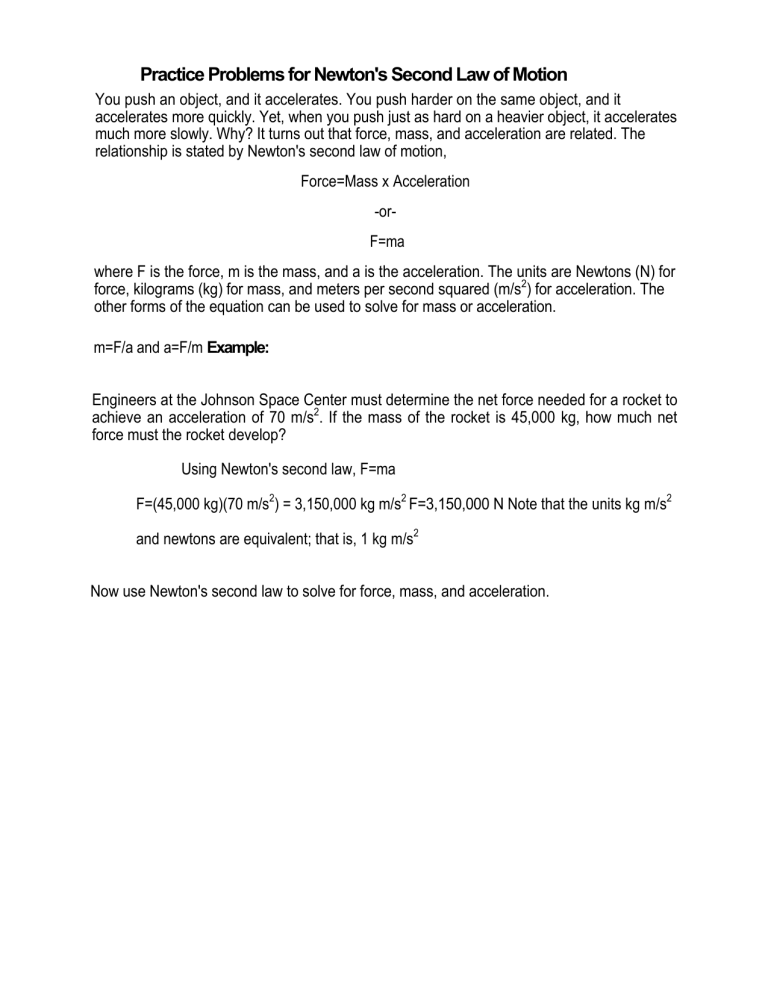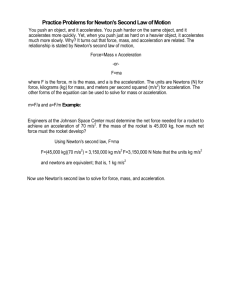
Practice Problems for Newton's Second Law of Motion You push an object, and it accelerates. You push harder on the same object, and it accelerates more quickly. Yet, when you push just as hard on a heavier object, it accelerates much more slowly. Why? It turns out that force, mass, and acceleration are related. The relationship is stated by Newton's second law of motion, Force=Mass x Acceleration -orF=ma where F is the force, m is the mass, and a is the acceleration. The units are Newtons (N) for force, kilograms (kg) for mass, and meters per second squared (m/s2) for acceleration. The other forms of the equation can be used to solve for mass or acceleration. m=F/a and a=F/m Example: Engineers at the Johnson Space Center must determine the net force needed for a rocket to achieve an acceleration of 70 m/s2. If the mass of the rocket is 45,000 kg, how much net force must the rocket develop? Using Newton's second law, F=ma F=(45,000 kg)(70 m/s2) = 3,150,000 kg m/s2 F=3,150,000 N Note that the units kg m/s2 and newtons are equivalent; that is, 1 kg m/s2 Now use Newton's second law to solve for force, mass, and acceleration. Give the equation used for each problem and show all work. 1. What net force is required to accelerate a car at a rate of 2 m/s2 if the car has a mass of 3,000 kg? F=_______ m=______ a= __________ 2. A10 kg bowling ball would require what force to accelerate down an alleyway at a rate of 3 m/s2? F=______ m=______ a=______ 3. Sally has a car that accelerates at 5 m/s2. If the car has a mass of 1000 kg, how much force does the car produce? F=______ m=______ a=______ 4. What is the mass of a falling rock if it produces a force of 147 N? F=______ m=______ a=______ 5. What is the mass of a truck if it produces a force of 14,000 N while accelerating at a rate of 5 m/s2 ? F=______ m=______ a=______ 6. What is the acceleration of softball if it has a mass of 0.5 kg and hits the catcher's glove with a force of 25 N? F=______ m=______ a=______ 7. Your own car has a mass of 2000 kg. If your car produces a force of 5000 N, how fast will it accelerate? F=_______ F=______ m=______ a=______ 8. Sally wants to accelerate even faster than in problem #3, so she removes 500 kg of mass from her car. How fast will her 1500 kg car accelerate if it produces 5000 N of force? F=______ m=______ a=______ 9. Sally challenges you to a race. On the first turn you run off the course and your car strikes a large bale of hay. Your car still produces 5000 N of force, but now it accelerates at only 2 m/s2. What is the mass of your car now that the bale of hay is stuck to it? F=______ m=______ a=______ 10. Even tough she is way ahead of you, Sally switches her car to run on nitrous oxide fuel. The nitrous oxide allows her car to develop 10,000 N of force. What is Sally's acceleration if her car has a mass of 500 kg? F=______ m=______ a=______



